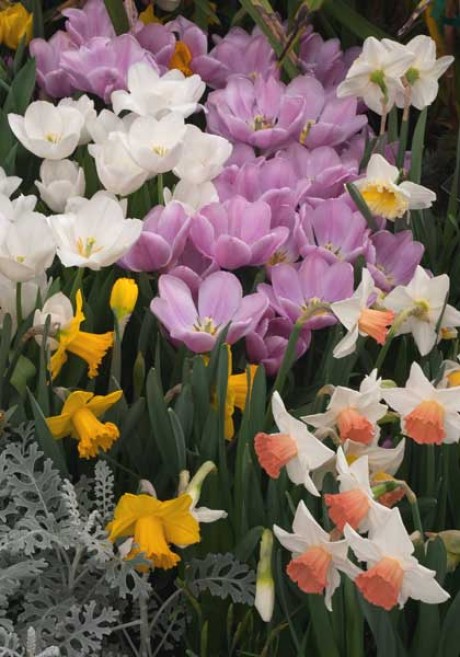The basics of spring-flowering bulbs
Plus Garden To-Do's for October and November
By L.A. JacksonBy now, the aisles of local lawn and garden centers are brimming with bins of tulips, daffodils, crocuses and other spring-flowering bulbs. This means it is not only time to buy but also to plant these special garden beauties!
And to get the blooming best out of your bulbs next spring, here are a few helpful tips to remember:
- Tame the temptation to buy “bargain” bulbs. Cheap bulbs are usually inferior in quality and often produce smaller or fewer flowers. They also sometimes take a year longer to bloom than their higher priced but healthier cousins.
- Try to buy bulbs that aren’t prepackaged but are in open bins instead. This allows you to examine each bulb as closely as you would, say, an onion or a tomato at the grocery store. Grab each bulb and give ‘em a squeeze. Healthy bulbs will be plump and firm. Also, size does matter — the largest bulbs in the bins usually have more flower power.
- If an Indian Summer extends warm weather deep into the fall, delay planting your bulbs. Ideally, the soil temperature should be around 60 to 65 degrees. While waiting for the cold to come, you can treat your bulbs to an early, beneficial chill by storing them in the refrigerator. Just remember to keep the sleeping bulbs away from ripening fruit, which emit ethylene gas that can be detrimental to the stored bulbs.
- Improve the tilth of the planting site by digging down at least 12 inches deep while adding plenty of compost or quality bagged topsoil.
- If moles or voles have a history of playing in your bulb beds, while turning over the soil, liberally mix in sharp pea gravel or, even better, a porous, soil-conditioning rock product called Perma-Til to discourage tunneling.
- Squirrels can also cause trouble in a planting bed by digging up bulbs, but this mischief can be stopped with a chicken wire barrier stretched across the growing ground. The wire can then be hidden with a layer of compost.
Garden To-Do's for October and November
October
- Pansies, anyone? Now is a great time to plant these persistent winter beauties. Adding a time-release fertilizer at planting time will help continue their flower production through the coldest part of the year, as will deadheading spent blooms over the next few months.
- To help prevent black spot next year, after leaf fall, rake up and discard the summer mulch and debris from under roses, and replace with fresh winter mulch. Do not compost the rakings.
- Want more hostas, cannas and daylilies? These favorite perennials can be dug up and divided now. And don’t forget to share some of them with other gardeners!
- Still have packets of seeds left over from your buying binge this growing season? To properly store them, put the packets in an airtight container and place them in a cool, dry, dark location to await a second chance to show off next spring.
November
- Frost is not completely unwelcome in the vegetable garden. This is especially the case with cold crops such as broccoli, Brussels sprouts, cabbage and cauliflower because a nipping from Jack Frost will turn some of the vegetable starch in the plants into sugar and make them sweeter tasting.
- Prune back cannas and discard the foliage to cut down on the population of leaf rollers that can overwinter in the debris and emerge next spring to continue their leaf-chewing problems.
- Back still throbbing from carrying in large whiskey barrel planters for the winter? A good cold weather project would be to add caster wheels to the bulky containers to make moving them in and out of protected spaces much easier.
- Grouping potted houseplants together indoors will provide a bit more humidity to help counteract the dry air typically found in warm winter homes.
-
Share this story:



